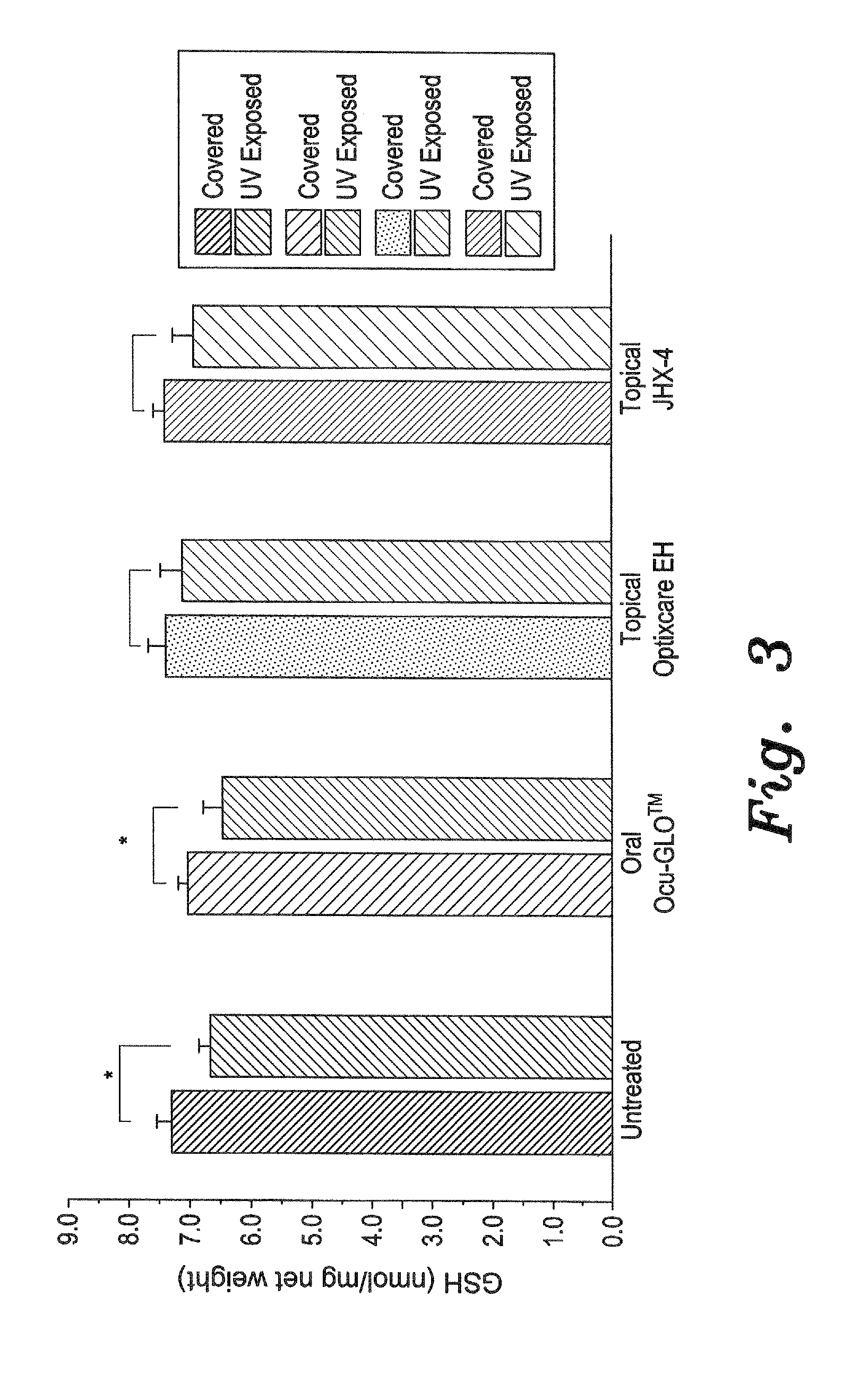Antioxidant eye drops
- Summary
- Abstract
- Description
- Claims
- Application Information
AI Technical Summary
Benefits of technology
Problems solved by technology
Method used
Image
Examples
example 1
Preparation of a 1 kg Formulation Containing 4% (wt / wt) Active Ingredients
[0032]Deionized water (750 g) was added into an appropriate sized stainless steel or glass vessel at room temperature, followed by 0.1 g of cetrimide to give a final concentration of 0.01%, and the mixture was stirred until dissolved. This was followed by the addition of 0.1 g of EDTA with stirring until dissolved to give a final concentration of 0.01%. Next, 57 g of 70% USP Sorbitol was added to give a final concentration of 5.7%, and the mixture was stirred until dissolved. This was followed by the addition of 40 g of resveratrol to give a final concentration of 4.0%. After the solution was well-mixed, 8 g of carbapol 980 was added to give a final concentration of 0.80%, and the mixture was stirred until completely hydrated. This was then followed by the addition of 40 g of ethyl pyruvate and 40 g of Camelia Sinesis extract (EGCG) to give a final concentration of 4% each. This solution was mixed for 5-10 min...
example 2
Diabetes-Induced Cataracts
[0033]For this study, diabetes was induced in young (100 g) Sprague Dawley rats by tail vein injection of 75 mg / kg of streptozotocin, as described by Randazzo et al. (PLoS One, 2011, 6(4), p. e18980). All rats with blood glucose levels >300 mg / dL were then equally divided into 4 groups of 6 each. The first group served as untreated controls, while the second group received 1 drop of the topical aldose reductase inhibitor Kinostat™ to each eye b.i.d. The third group topically received 1 drop of the present antioxidant eye drops composition, prepared as described above and referred to as Optixcare EH, to each eye b.i.d. The fourth group once daily orally received 1 mL of tween 80 Ocu-GLO™ solution, which was prepared by dissolving the contents in capsules of Ocu-GLO™ (Animal Health Quest, Bellingham, Wash.) in an appropriate amount of Tween 80 so that administration of 1 mL of the Tween mixture was delivered per the manufacturer's suggested dosage of nutraceu...
example 3
UV-Induced Cataracts
[0035]Exposure to UV irradiation is another major risk factor of cataractogenesis. UV-irradiation induces ROS, which results in a rapid loss of reduced lens gluthione (GSH), the major antioxidant in the lens, followed several weeks later by subsequent lens opacification. For this study, young female Sprague Dawley rats were divided into five equal groups. One group served as the non-irradiated control group, while the second group served as the untreated irradiated control group. The third group received topical Optixcare carbomer vehicle containing 3% JHX-4 (4-(5-hydroxypyrimidin-2-yl)-N,N-dimethyl-3,5-dioxopiperazine-1-sulfonamide (99% pure by HPLC), the fourth received the present antioxidant eye drops composition, prepared as described above and referred to as topical Optixcare EH, and the fifth group received 1 mL of the oral Ocu-GLO™ by gavage, as described above. Treatments began 3 days prior to irradiation and continued until termination of the experiment...
PUM
| Property | Measurement | Unit |
|---|---|---|
| Fraction | aaaaa | aaaaa |
| Fraction | aaaaa | aaaaa |
| Fraction | aaaaa | aaaaa |
Abstract
Description
Claims
Application Information
 Login to View More
Login to View More - R&D
- Intellectual Property
- Life Sciences
- Materials
- Tech Scout
- Unparalleled Data Quality
- Higher Quality Content
- 60% Fewer Hallucinations
Browse by: Latest US Patents, China's latest patents, Technical Efficacy Thesaurus, Application Domain, Technology Topic, Popular Technical Reports.
© 2025 PatSnap. All rights reserved.Legal|Privacy policy|Modern Slavery Act Transparency Statement|Sitemap|About US| Contact US: help@patsnap.com



